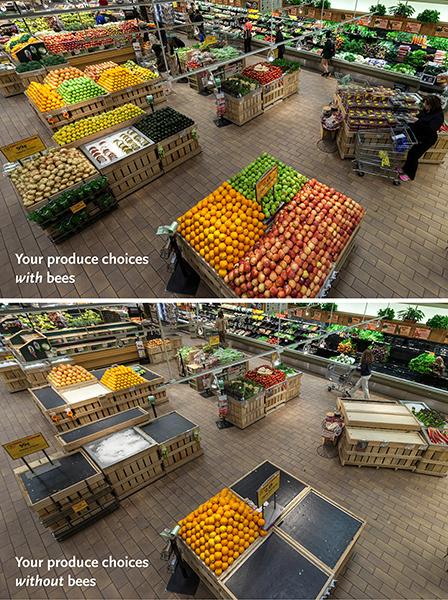
By now, we’ve all seen the before-and-after photo (above) illustrating what our grocery stores would look like if pollinators disappeared from our food system. Given our well-established intolerance of threats to our (pollinator-dependent) avocado supply (Guacapocalypse, anyone?), it was only a matter of time before the President himself would step in to help save the honeybees and hoverflies.
The White House recently issued a presidential memorandum establishing a federal task force to develop a strategy for reversing the declining populations of pollinators. In addition to ensuring the availability of our avocados, pollinators are important for a myriad of ecological and economic reasons—and are a perfect example of the interdependent socio-environmental systems on which SESYNC focuses. But pressures such as habitat loss and degradation, pesticides, and climate change threaten these busy workers and the ecosystem services they provide. In response, the President’s Pollinator Health Task Force is charged with focusing federal efforts to research, prevent, and recover from pollinator losses; to develop a public education campaign that teaches people about how they can help pollinators in their own communities; and to take specific measures to substantially expand pollinator habitat on federal lands, as well as build on federal efforts with public–private partnerships.
The memo establishes pollinator protection as a national priority: an important step in the right direction. And because the federal government owns a great deal of land (roughly 635–640 million acres), it has an opportunity to make a big impact through its management strategies for increasing and improving pollinator habitat on those lands.
The memo’s Pollinator Research Action Plan also opens the door for synthesis amongst the agencies and organizations already doing good work on pollinators. Many of the items identified in the memo’s Pollinator Research Action Plan are being studied by the U.S. Department of Agriculture (including its Colony Collapse Disorder Steering Committee), U.S. Environmental Protection Agency, and a number of state land grant institutions and non-profits, such as The Xerces Society and the North American Pollinator Protection Campaign. Dr. David Hawthorne, SESYNC’s Director of Education and Outreach and Associate Professor of Entomology at the University of Maryland, is hopeful that the federal task force will aggregate the information and perspectives from these diverse sources with those of the agencies tasked with creating the action plan to effectively synthesize both the ecological and the social information needed to develop an effective plan.
But does the memorandum go far enough? The pollinator crisis is a remarkably complex problem, shaped by different landscapes and plant communities; insect, bat, and bird populations; and numerous land uses and governmental jurisdictions. And although economic concerns are a prominent impetus for the memorandum, the engagement of social scientists appears lacking in the research plan.
“The plan could end up a traditional, natural science-oriented search for solutions and best practices,” says Hawthorne. “One thing that would make it stronger would be to include social science and governance expertise. How, for example, does improving pollinator habitat impact the utility of the land for the people who use it? If improved pollinator habitat is at odds with another designated land use, how does that conflict affect the vitality of the pollinator habitat over time?”
SESYNC’s Quantitative Programs Researcher Kelly Hondula notes that we don’t necessarily recognize negative impacts on pollinators or ecosystem services until it affects us personally—until we see, for example, either a sharp rise in avocado prices at the grocery store or their complete disappearance from produce displays.
“The point of understanding pollination as an ecosystem service that underlies the things we care about,” says Hondula, “is to prevent that price spike or product loss before it happens in the first place, because intervention is better, easier, and cheaper than trying to recover something after it’s lost.”
The social science perspective, therefore, would be important to an effective pollinator research and action plan because it would provide a context for valuation of trade-offs. The complexity of the pollinator crisis means there’s no single, silver bullet solution. Potential solutions should be evaluated within a socio-environmental framework to determine at what “costs” we are willing to save our pollinators … and our avocados.
The National Socio-Environmental Synthesis Center, funded through an award to the University of Maryland from the National Science Foundation, is a research center dedicated to solving complex problems at the intersection of human and ecological systems.